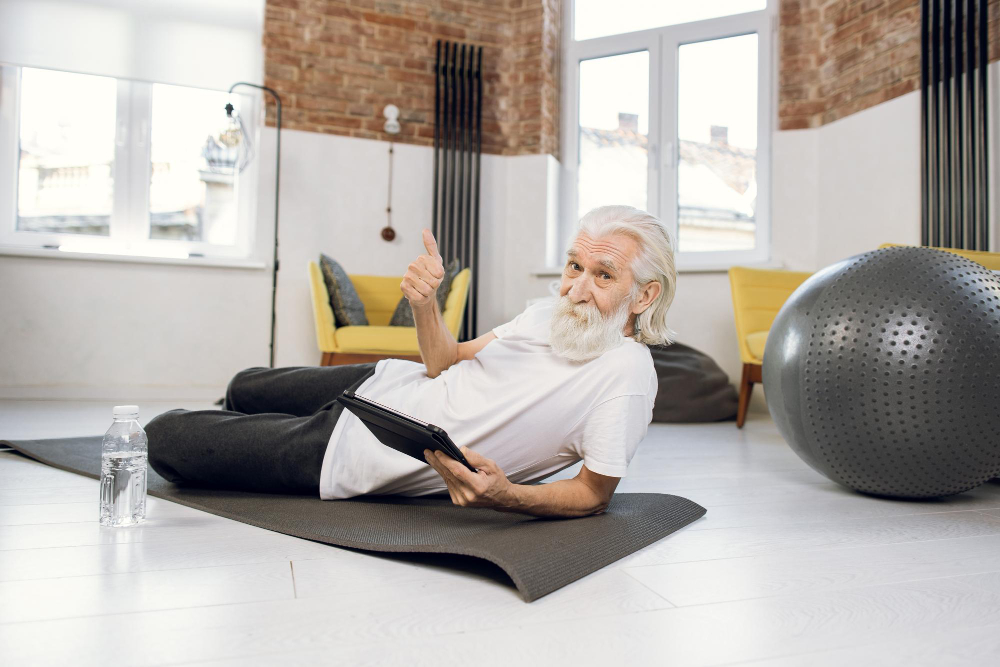Table of Contents
Introduction
What is Chair Yoga?
Chair yoga is a gentle form of yoga that is practiced while sitting on a chair or standing and using the chair for support. It’s perfect for seniors because it offers the benefits of traditional yoga without the need to get down on the floor or worry about balance.
Importance of Chair Yoga for Seniors
As we age, maintaining physical activity becomes crucial for overall health. Chair yoga provides a low-impact way to improve flexibility, strength, and mental well-being. It’s accessible to everyone, regardless of mobility limitations.
Benefits of Chair Yoga for Seniors
Physical Benefits
Chair yoga helps improve flexibility, strength, and balance, reducing the risk of falls. It also enhances circulation and can help manage chronic conditions like arthritis and hypertension.
Mental and Emotional Benefits
Engaging in chair yoga can reduce stress, anxiety, and depression. It promotes mindfulness and relaxation, contributing to a better quality of life.
Getting Started with Chair Yoga
Choosing the Right Chair
Select a sturdy chair without wheels. Ensure it has a flat seat and provides good support. Avoid using soft or cushioned chairs that might affect your posture.
Preparing the Environment
Find a quiet space with enough room to stretch out your arms and legs. Keep the area free of clutter to avoid any accidents.
Setting Realistic Goals
Start slow and set achievable goals. Begin with short sessions and gradually increase the duration as you become more comfortable with the poses.
Basic Chair Yoga Poses
Seated Mountain Pose
Sit tall with your feet flat on the ground and your hands resting on your knees. Inhale and lengthen your spine, reaching the crown of your head towards the ceiling. This pose improves posture and prepares you for other movements.
Seated Forward Bend
From the seated mountain pose, exhale and hinge forward from your hips, reaching your hands towards your feet. This stretch releases tension in the back and hamstrings.
Seated Twist
Place your right hand on the back of the chair and your left hand on your right knee. Inhale to lengthen your spine, then exhale to twist gently to the right. Hold for a few breaths and repeat on the other side. Twists aid in digestion and spinal flexibility.
Advanced Chair Yoga Poses
Seated Warrior Pose
Sit on the edge of the chair with your feet wide apart. Turn your torso to the right and extend your left leg behind you, keeping your toes on the ground. Raise your arms to shoulder height, parallel to the ground. This pose builds strength in the legs and arms.
Seated Cat-Cow Stretch
Place your hands on your knees. Inhale and arch your back, lifting your chest and looking up (cow pose). Exhale and round your spine, tucking your chin to your chest (cat pose). This flow improves flexibility and relieves tension in the spine.
Seated Pigeon Pose
Cross your right ankle over your left knee, keeping your right foot flexed. Gently press your right knee down, feeling a stretch in your hip. Hold for a few breaths and switch sides. This pose is great for hip mobility and relieving lower back pain.
Safety Tips for Seniors Practicing Chair Yoga
Listening to Your Body
Pay attention to how your body feels. Don’t push yourself too hard. If a pose causes pain, stop immediately.
Using Support When Needed
Feel free to use props like yoga blocks, straps, or cushions to support your practice. These can help you maintain proper alignment and comfort.
Modifying Poses for Comfort
Modify poses as needed to suit your body’s abilities. It’s okay to skip poses that feel uncomfortable or challenging.
Incorporating Chair Yoga into Daily Routine
Incorporating chair yoga into your daily routine can be a great way to enhance your flexibility, strength, and overall well-being, especially if you have limited mobility or spend a lot of time sitting. Here’s a guide to help you integrate chair yoga into your day:
Benefits of Chair Yoga
- Improved Flexibility: Helps stretch and lengthen muscles.
- Increased Strength: Strengthens muscles, especially core and leg muscles.
- Enhanced Circulation: Promotes blood flow, reducing the risk of blood clots and other circulatory issues.
- Stress Reduction: Encourages relaxation and mindfulness.
- Better Posture: Helps correct alignment and improve posture.
Getting Started
- Choose the Right Chair: Select a sturdy chair without wheels. Ensure it has a straight back and allows your feet to rest flat on the ground.
- Wear Comfortable Clothing: Opt for clothes that allow free movement.
- Set a Time: Pick a consistent time each day for your practice, whether it’s in the morning, during a lunch break, or in the evening.
Simple Chair Yoga Poses
- Seated Mountain Pose (Tadasana):
- Sit tall with your feet flat on the ground.
- Align your head, neck, and spine.
- Rest your hands on your thighs, palms down.
- Take deep breaths, feeling your spine lengthen.
- Seated Cat-Cow Stretch:
- Place your hands on your knees.
- Inhale, arch your back, and look up (Cow Pose).
- Exhale, round your spine, and tuck your chin to your chest (Cat Pose).
- Repeat for several breaths.
- Seated Forward Bend (Paschimottanasana):
- Sit on the edge of your chair.
- Extend your legs out in front of you with your heels on the ground.
- Inhale, lengthen your spine.
- Exhale, fold forward, reaching for your toes.
- Hold for a few breaths, and then slowly come back up.
- Seated Twist (Ardha Matsyendrasana):
- Sit sideways on the chair, with your left side facing the chair back.
- Twist your torso to the left, holding onto the chair back.
- Keep your spine tall and twist from the waist.
- Hold for a few breaths, then switch sides.
- Seated Pigeon Pose (Eka Pada Rajakapotasana):
- Sit tall with your feet flat on the ground.
- Place your right ankle on your left thigh, just above the knee.
- Flex your right foot and gently press down on your right knee.
- Hold for a few breaths, then switch sides.
Integrating Chair Yoga into Your Day
- Start Your Day with Yoga: Begin your morning with a short chair yoga routine to wake up your body and mind.
- Break Up Your Workday: Incorporate a few poses during your breaks to relieve tension and boost energy.
- Evening Relaxation: Wind down your day with a gentle chair yoga session to promote relaxation and better sleep.
- Consistency is Key: Aim to practice daily, even if it’s just for 5-10 minutes. Consistency will yield the best results.
Tips for Success
- Listen to Your Body: Never push yourself into a pose that causes pain. Modify as needed.
- Focus on Breath: Use your breath to guide your movements and enhance relaxation.
- Stay Hydrated: Drink water before and after your practice to stay hydrated.
- Enjoy the Process: Remember that yoga is a journey, and every practice contributes to your overall well-being.
Related Article:
- Best Chair Yoga for Seniors
- Link this when discussing the physical benefits of chair yoga, as it lists the best poses for seniors to improve flexibility and strength.

Common Misconceptions About Chair Yoga
Chair yoga is an accessible form of exercise that can be beneficial for people of all ages and fitness levels. However, several misconceptions about chair yoga can deter people from trying it. Let’s address and debunk some of these common myths:
1. Chair Yoga is Only for Seniors
Misconception: Chair yoga is often perceived as an activity only suitable for elderly individuals or those with significant physical limitations. Reality: While chair yoga is indeed beneficial for seniors and people with mobility issues, it is also a great option for anyone looking to incorporate gentle stretching and mindful movement into their day. Office workers, athletes recovering from injuries, and individuals new to yoga can all benefit from chair yoga.
2. Chair Yoga is Not a Real Workout
Misconception: Some believe that chair yoga does not provide a substantial workout and is too easy to yield any real benefits. Reality: Chair yoga can offer a robust workout, enhancing strength, flexibility, and balance. It can also be adapted to various intensity levels, making it possible to increase the challenge as you progress.
3. You Don’t Get the Full Benefits of Yoga
Misconception: People often think that chair yoga does not provide the full spectrum of yoga benefits, such as improved mental clarity and reduced stress. Reality: Chair yoga incorporates many traditional yoga principles, including breathwork, mindfulness, and meditation. These elements contribute to its mental and emotional benefits, just like any other form of yoga.
4. You Need Special Equipment
Misconception: There is a belief that chair yoga requires special equipment or a specific type of chair. Reality: All you need for chair yoga is a sturdy, stable chair without wheels. It doesn’t require any specialized equipment, making it easy to practice at home, in the office, or even while traveling.
5. Chair Yoga is Boring
Misconception: Some might assume that chair yoga lacks variety and excitement compared to traditional yoga classes. Reality: Chair yoga can be quite dynamic and varied. There are numerous poses and sequences that can be performed using a chair, targeting different muscle groups and keeping the practice engaging and enjoyable.
6. You Must Be Injured or Disabled to Practice Chair Yoga
Misconception: Many think that chair yoga is exclusively for people who are injured or have disabilities. Reality: Chair yoga is for everyone, regardless of physical condition. It is an excellent option for those looking for a low-impact exercise routine, individuals wanting to practice yoga in a seated position, or anyone seeking a gentle way to stay active.
7. It’s Too Easy to Be Effective
Misconception: Some believe that chair yoga is too gentle to be effective in improving strength or flexibility. Reality: Chair yoga can be surprisingly challenging, especially when incorporating balance and strength-building exercises. It is an effective way to enhance overall fitness, and the difficulty can be adjusted to match your fitness level.
Embracing Chair Yoga
Understanding the realities of chair yoga can help you appreciate its value and versatility. Whether you are new to yoga, have physical limitations, or are simply looking for a convenient way to incorporate more movement into your day, chair yoga is a fantastic option that offers numerous physical, mental, and emotional benefits. Give it a try, and you might be surprised by how much it enhances your well-being.
Related Article:
- Chair Yoga for Seniors: A Free Guide to Enhanced Wellbeing
- This article could be linked when mentioning the accessibility of chair yoga, providing readers with a free resource to get started.
DIY Chair Yoga Practice
Creating a DIY chair yoga practice at home can be a simple, effective way to integrate the benefits of yoga into your daily routine. Here’s a step-by-step guide to help you get started:
Setting Up Your Space
- Choose a Quiet Spot: Find a peaceful area where you won’t be disturbed. This helps create a calming environment conducive to relaxation and focus.
- Select a Sturdy Chair: Use a stable chair without wheels. Ideally, the chair should have a straight back and no armrests to allow for a full range of motion.
- Wear Comfortable Clothing: Opt for clothing that allows you to move freely.
Basic Chair Yoga Routine
Warm-Up
- Seated Mountain Pose (Tadasana)
- Sit tall with your feet flat on the floor.
- Rest your hands on your thighs.
- Close your eyes and take several deep breaths, lengthening your spine with each inhale.
- Neck Stretches
- Gently tilt your head towards your right shoulder, stretching the left side of your neck.
- Hold for a few breaths, and then switch sides.
Poses
- Seated Forward Bend (Paschimottanasana)
- Sit on the edge of your chair.
- Extend your legs out in front of you, with your heels on the floor.
- Inhale to lengthen your spine, then exhale and fold forward, reaching for your toes or shins.
- Hold for several breaths, feeling the stretch along your back and legs.
- Seated Cat-Cow Stretch
- Place your hands on your knees.
- Inhale, arch your back, and lift your chest (Cow Pose).
- Exhale, round your spine, and tuck your chin to your chest (Cat Pose).
- Repeat 5-10 times, coordinating your breath with the movements.
- Seated Twist (Ardha Matsyendrasana)
- Sit sideways on the chair, with your left side facing the chair back.
- Place your hands on the chair’s back and twist your torso to the left.
- Keep your spine long and twist from the waist.
- Hold for several breaths, then switch sides.
- Seated Pigeon Pose (Eka Pada Rajakapotasana)
- Sit tall with your feet flat on the ground.
- Place your right ankle on your left thigh, just above the knee.
- Flex your right foot and gently press down on your right knee.
- Hold for a few breaths, then switch sides.
- Seated Side Stretch
- Raise your right arm overhead and lean to the left, stretching the right side of your body.
- Hold for a few breaths, then switch sides.
Cool Down
- Seated Shoulder Rolls
- Roll your shoulders up, back, and down in a circular motion.
- Do this 5-10 times, then reverse the direction.
- Seated Forward Bend with Rest
- Sit back in your chair with your feet flat on the ground.
- Hinge forward from your hips, resting your torso on your thighs.
- Let your head hang down and relax your arms towards the floor.
- Hold for a few breaths, then slowly roll back up.
- Breath Awareness
- Sit comfortably with your hands on your thighs.
- Close your eyes and take several deep breaths, focusing on the sensation of the breath entering and leaving your body.
- Spend a few minutes in this meditative state, allowing your body and mind to relax.
Tips for a Successful Practice
- Start Slow: Begin with a few basic poses and gradually increase the duration and complexity as you become more comfortable.
- Listen to Your Body: Never force yourself into a pose. Modify as needed to avoid discomfort or strain.
- Consistency is Key: Aim to practice daily, even if it’s just for 5-10 minutes.
- Incorporate Breathwork: Focus on your breath throughout the practice to enhance relaxation and mindfulness.
- Enjoy the Process: Chair yoga should be a pleasant and rewarding experience. Celebrate your progress and enjoy the journey.
By following this DIY chair yoga routine, you can experience the many benefits of yoga from the comfort of your own home. Whether you’re a beginner or looking for a gentle way to stay active, chair yoga is a versatile and accessible option.
Related Article:
- Unlock the Benefits of Chair Yoga
- It is useful for readers interested in the comprehensive benefits of chair yoga, including mental and emotional health improvements.
Conclusion
Chair yoga offers a wonderful opportunity for seniors to stay active, improve their health, and enhance their quality of life. With its accessibility and numerous benefits, it’s a practice worth incorporating into your daily routine. So why wait? Grab a chair and start your yoga journey today!







